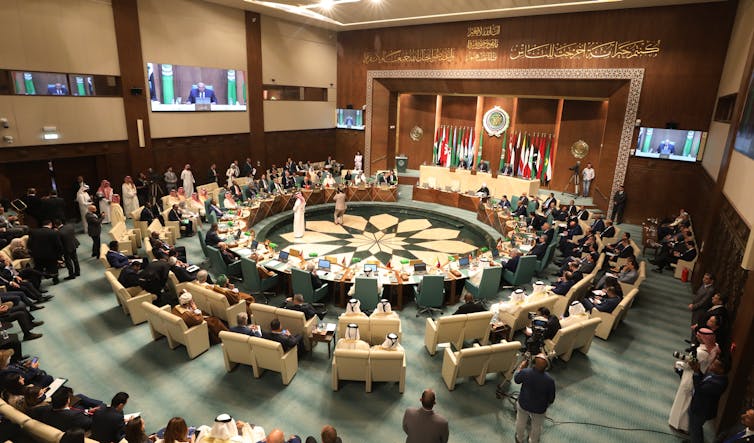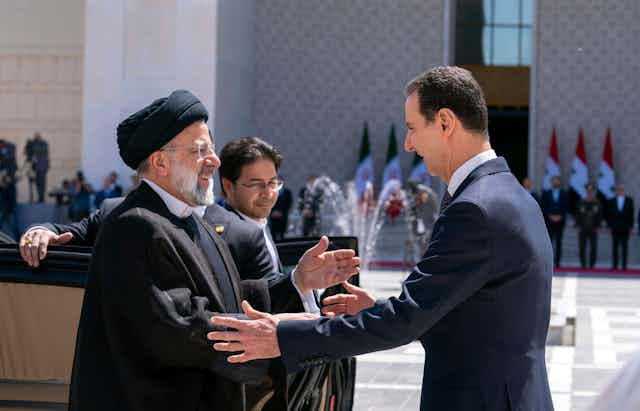In the carefully composed photograph released by their state news agencies at the beginning of May, Syria’s leader Bashar al-Assad has his arms outstretched to welcome the Iranian president, Ebrahim Raisi. The two men are beaming.
Raisi’s visit was a sign of Tehran’s essential support for Assad, more than 12 years after the Syrian leader’s bloody repression of a popular uprising that called for reform and guarantees of human rights. The meeting was also an attempt to portray that both leaderships are stable and in control amid Assad’s quest for normalisation and re-entry into the regional community of nations.
But it’s a facade. The template agreements for “strategic cooperation” and declaration of Iranian support for Assad via “sovereignty” cannot knit together a Syria that is fractured, perhaps for the long term. They cannot provide relief for Syrians facing inflation and shortages of food, fuel and utilities, let alone the 11 million — almost half of the pre-conflict population — who are refugees or internally displaced.
Nor can they sweep aside ten months of Iran’s nationwide protests, sparked by the death in police custody of Mahsa Amini after her detention and reporting beaten for “inappropriate attire”. They cannot end the standoff over Tehran’s nuclear programme or lift US and European sanctions. And despite Iran-backed attacks on American personnel in the region, they cannot break US support for the Kurdish administration in northeast Syria.
Seven weeks after the Assad-Raisi photo in Damascus, another international meeting in mid-June testified to the illusions of an Iran-Syria “Axis of Resistance”.
In Kazakhstan’s capital, the Assad regime was joining the six and a half-year “Astana process” – the UN-sponsored agreement between Iran, Russia, and Turkey to monitor its 2016 ceasefire for the first time in that part of Syria. This would be a sign of Damascus being actively involved in the supposed resolution of the March 2011 uprising.
But as soon as the session began, illusion met reality. The regime’s deputy foreign minister, Ayman Sousan, demanded Turkey withdraw its forces from opposition territory in northwest Syria. The Turks unsurprisingly refused. They wanted the gathering to put pressure on the Kurdish administration in northeast Syria, which Ankara sees as part of the Turkish Kurdish insurgency PKK.
But that raises the challenge of confronting the US, the backer of the Kurds and the Syrian Democratic Forces, who had helped evict the Islamic State from the country in 2019. Russia, embroiled in Vladimir Putin’s failing invasion of Ukraine, showed no appetite for a showdown with Washington.
So everyone went home with nothing beyond Moscow’s declaration: “This is a very crucial process.”
Moving pieces
The two days in Astana highlighted the difficulty for both the Assad regime and Iran. In a Middle East kaleidoscope of many moving pieces, it is daunting for either to line up all of them.
Assad’s headline ploy has been the restoration of relations with Arab states, hoping to break political isolation and his economic bind. There has been success: UAE and Bahrain reopening embassies; Assad’s visits to the Emirates and Oman; and re-entry into the Arab League in May, with Saudi Arabia — once the leading supporter of anti-Assad factions — welcoming Assad to the summit in Jeddah.

However, that process runs head-on into Assad’s reliance on Iran to maintain control over even part of Syria, given the longtime rivalry between Tehran and some Arab states — notably Saudi Arabia — throughout the region.
An Arabian pipedream?
The solution to the conundrum is a grand reconciliation, in which Iran would also repair its position in the region. In March, Iran and Saudi Arabia announced the resumption of diplomatic ties more than seven years after they were broken.
The China-brokered deal was accompanied by a high-level Iranian visit to the UAE. Tehran spoke loudly about the prospect of billions of dollars of Gulf investments in its battered economy.
Read more: Saudi-Iran deal won't bring peace to the Middle East but will enhance China's role as power broker
The manoeuvres freed the Iranian leadership from an immediate crisis. Amid the nationwide protests, its currency had almost halved in value, sinking to 600,000:1 against the US dollar. The easing of tensions with the Arab states, as well as talk of an “interim deal” with the US over the nuclear programme, helped lift the rial to 500,000:1, relieving pressure on an official inflation rate of 50%, with increases for food about 75% per year.
But this is a tentative respite. Saudi Arabia and Iran remain on opposite sides in the Yemen civil war. They back different factions in Lebanon’s long-running political and economic turmoil. Gulf States are wary about the renewal of Iran-backed attacks on Iraqi bases which host US personnel, as well as any further moves by Tehran towards the capacity for a nuclear weapon.
Meanwhile, the International Crisis Group has highlighted the unending instability in the Assad-held part of Syria. No Gulf country is likely to want to spend significant sums in support of his regime. Syria is far from their top priority, and it offers poor returns on investment. They cannot realistically hope to compete with the influence that Tehran has built through years of military engagement.
Western sanctions limit potential economic gains – and US sanctions in particular impose major legal barriers and political costs. Also, investing large amounts in Syria with a devastated infrastructure, an impoverished population with little purchasing power, a predatory regime and dismal security in the areas it nominally controls would be like pouring money into a bottomless pit.
Assad can still pose before the cameras to claim legitimacy. But his Iranian backers are entangled in domestic difficulties, his Russian backers are being sapped of strength by Putin’s deadly folly in Ukraine, and his would-be Arab escape route is far from assured.

